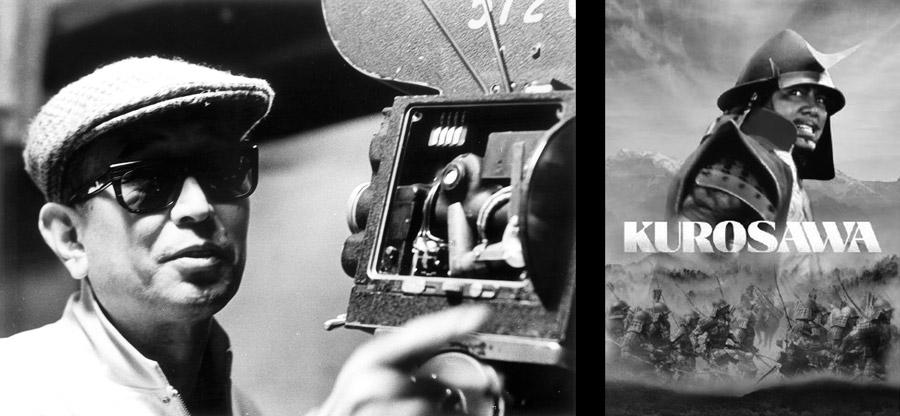“Success isn’t worth losing your humanity,” proclaims Reiko (Kyōko Kagawa) to her husband, Kingo Gondo (Toshiro Mifune), in Akira Kurosawa’s 1963 crime thriller, High and Low. A sentiment that sets in motion the primary thesis of the Japanese filmmaker’s humanitarian masterpiece.
Spurred into crisis when his chauffeur’s son, Shinichi (Masahiko Shimizu) is mistakenly kidnapped in place of his own, Gondo, the wealthy executive of a successful shoe company, at the cusp of the most important business transaction of his career, is thrust into an ultimatum in which he must decide whether ¥30 million is worth a human life.

A Tale in Two Places (High and Low)
Both police procedural and economic class drama, High and Low is told in two parts: the kidnapping and eventual rescue of Shinichi, and the following investigation and tracking down of the kidnapper, Ginjirô Takeuchi (Tsutomu Yamazaki). Centred around a suffocating conundrum, in which Gondo either pay Shinichi’s ¥30 million ransom and lose out on securing the majority shares of his shoe company, or refuse the kidnapper and risk being defamed by the media, Kurosawa presents the first half of the film almost entirely in Gondo’s luxurious apartment.
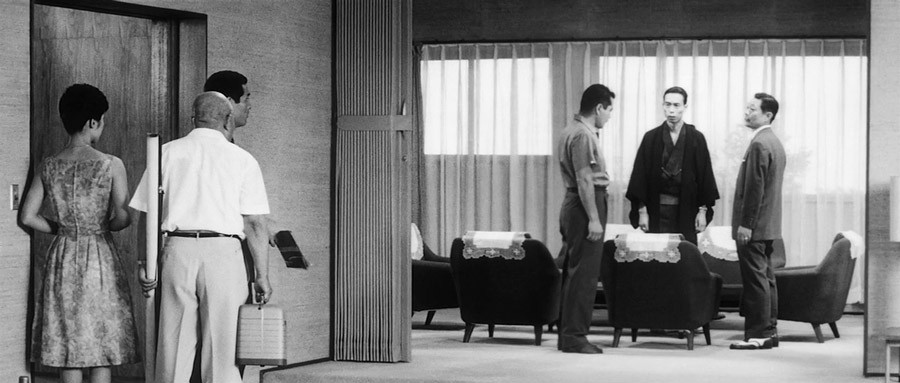
Positioned at the top of a hill, looking out over the city, the grandiosity of Gondo’s livelihood contrasts despairingly with the musky, murky destitution of downtown Tokyo. Through careful production design, Kurosawa conveys the inequality between social classes by presenting a space, unlittered and unaffected by a massive heatwave, while the rest of the city swelters below.
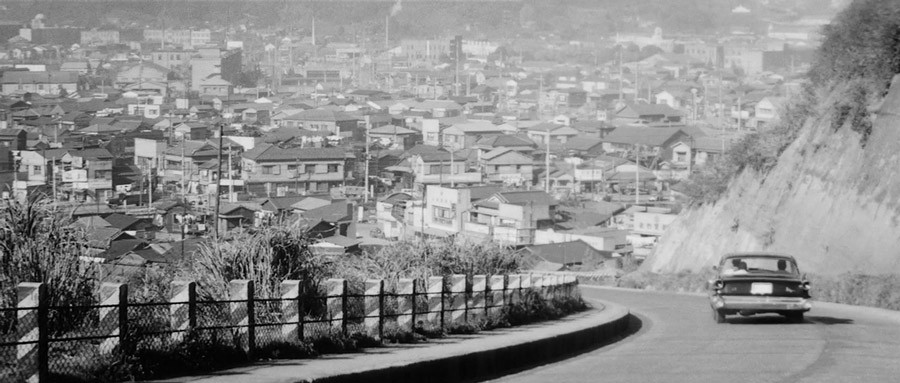
In the second half of the film, as the police venture through the blustering beating heart of Tokyo, the setting becomes oppressive, characterised by cars and crowds, the bustle of a modern metropolis. Characters carry hand fans while the police station is littered with electrical ones which whir in tandem with the noise pollution of the city, while in Gondo’s apartment, it is cool and quiet: a wide open space with white clean walls, exuberant furniture and lavish tall glass windows which further widen the space. By juxtaposing the film’s two major settings, Kurosawa evokes the film’s title, which, in Japanese, can be read as heaven and hell. The first half of the film presents the heavenly lives of the wealthy, in all its excess, while the latter, with bustling alleys laden with drug addicts and grease, represents the dungy hell of the city.
Book VS Film
Adapted from American author Evan Hunter’s 1959 novel King’s Ransom, High and Low was somewhat of a career departure for Kurosawa, whose earlier adaptations, such as Throne of Blood (1957) and The Lower Depths (1957), were generally of European and Russian origin; in this case by Shakespeare and Maxim Gorky respectively. High and Low originates from America, yet as with all his adaptations, Kurosawa puts his swing on things, turning what is arguably a paint-by-numbers police procedural with an interesting twist into something much more humanistic.
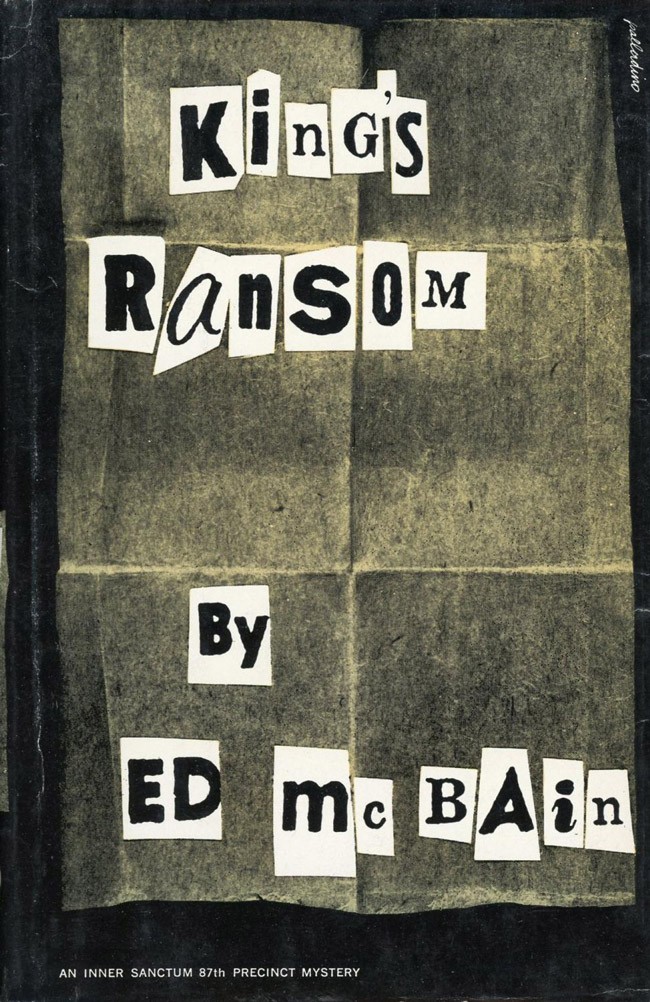

In the source novel, Malcolm King, Gondo’s American equivalent, also plots to buy out his company from the hands of his partners, yet is thwarted when his chauffeur’s son is kidnapped in place of his own. In both versions, the respective businessmen must either pay the ransom, but risk falling financially or decide not to pay the ransom and risk morally bankrupting themselves.
The difference between the book and the film is that in the former, King decides not to pay the ransom, yet is not vilified for it. Whereas in High and Low, Gondo decides not to pay the ransom, and society hails him for it yet, in doing so, his partners buy his share of the company and boot him out entirely. This is perhaps the most notable of Kurosawa’s embellishments, claiming to have been “impressed chiefly by the audacity of the kidnappers’ demand that the businessman nonetheless pays the ransom, a sum that will wipe him out.” In High and Low, Kurosawa establishes a more humanitarian position, allowing his central character to save the boy, even if it means falling considerably in the world.
Through careful blocking and composition, Kurosawa commits to the moral conflict of the film, using a super widescreen to disperse and/or crowd his characters to evoke certain emotions. In an early moment in the film, as Gondo wrestles with the decision to save the boy and risk his entire livelihood, he stands alone in the corner of the right of the screen, facing down, while his assistant, Kawanishi (Tatsuya Mihashi) stands at the opposite side. A loyal servant of Gondo for years, Kawanishi presses Gondo to follow through with the deal, bearing little concern for the safety of Shinichi while Aoki (Shinichi’s father) grovels for the safety of his son.
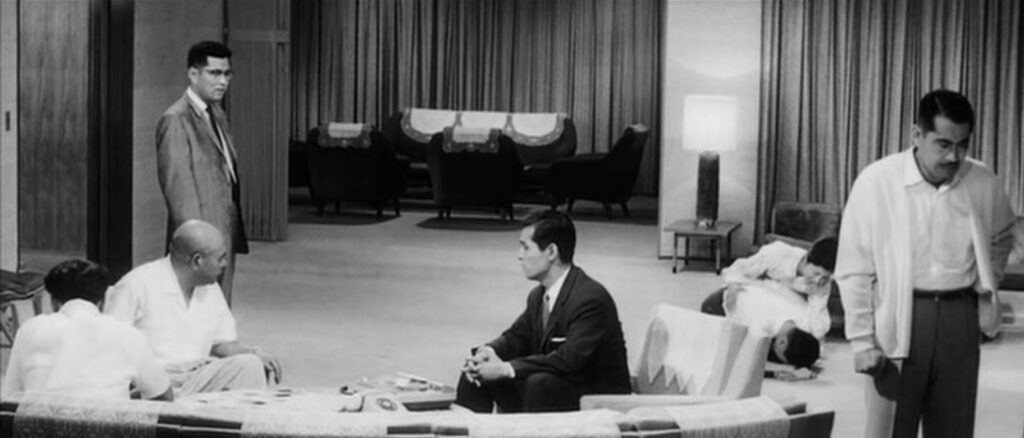
Although restricted to the left of the screen, Mifune’s performance brings Gondo’s moral conflict to the forefront, fidgeting and pacing with fists held tight, refusing to face the despairing father behind him, while the central police convey a more neutral stance, turning away from Aoki’s emotional outburst, apathetic and obligated to follow whatever Gondo decides to do. By splitting the frame into parts, Kurosawa reflects the three stances in a single image: Kawanishi stands left, determined to buy the company; the police sit in the middle, apathetic and merely here to do their job; while on the right, Aoki’s desperately pines at his employer’s humanity: “Please save, Shinichi!”

The cluttered frame creates a claustrophobic effect as if to illustrate how Gondo’s life has been upturned by the kidnapping. He paces, unsure how to proceed while Kawanishi takes his leave, using Gondo’s indecision as an excuse to confirm the deal and condemn Shinichi. It is only when Reiko invades the space, comforting Aoki and beseeching her husband to save Shinichi, that Gondo decides to choose humanity and postpone the deal at the detest of Kawanashi.
No Hero
There is no hero in High and Low. Not really. There is Gondo, whose decision to save Shinichi is no more heroic than it is an act of self-preservation, either appeasing the kidnapper’s demands or suffering society’s reaction. There is Aoki and Reiko, whose significant moral virtues while heroic, are downplayed by minimal screentime, and merely implemented to influence Gondo’s decision. Not even the police are that heroic, working to assist Gondo in whatever decision he makes and catch the criminal, with little care of who suffers along the way. There is a telling moment during a police chase, where a heroin addict is pretty much allowed to die at the hands of the kidnapper. Knowing full well that he intends to test a fatal dose of heroin on the addict, the police do nothing, simply letting it happen as just another victim in a series of crimes.

You could argue that the kidnapper, Takeuchi, is the hero, using whatever means necessary to take money from a rich and morally dubious businessman, as a way to balance out the overt inequality presented in the film. A medical intern, a surprisingly high-end capacity for a disgruntled lower-class worker, Takeuchi lives in a cramped apartment, overlooked by Gondo’s luxurious palace on the hill. He lives in Gondo’s shadow, poverty-stricken and suffering the weight of class equality wherein a successful shoe seller is rewarded with financial capital, while a trained medical professional, is left to freeze or boil in poverty. Seems pretty unfair if you ask me.

In the film’s final scene, in which Gondo and Takeuchi are brought face to face in a prison visitor’s room, separated by a glass barrier which reflects each other’s faces, the ambiguous morality of each character is brought into question. Gondo asks why Takeuchi wanted to see him, and his answer is unclear. This is a moment that almost begs for a moral reckoning, in which the criminal is given a chance to repent. Yet, Takeuchi refuses, laughing manically and rejecting Gondo’s request for an explanation. Kurosawa leaves the film on an ambiguous note, almost as ambiguous as the characters it inhabits.
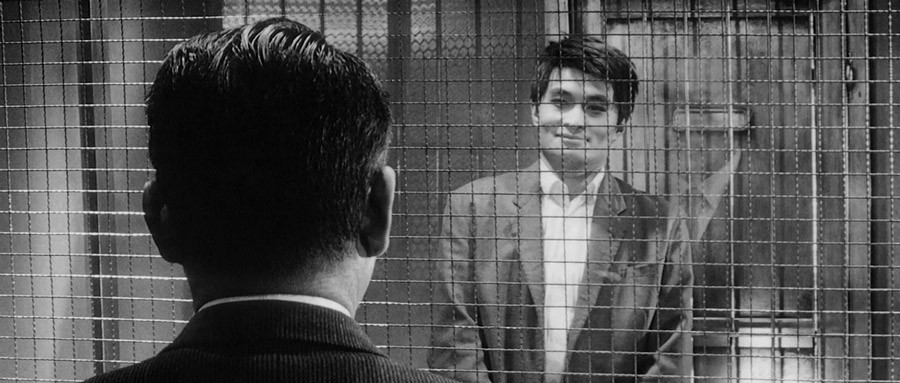
Changing Times
High and Low is a film about Japan. Set during the postwar era, after years of occupation, and the country’s isolation period in which foreign policy severely limited relations and trade, the film reflects the anxieties of a country struggling to come to terms with the saturating effect of globalisation. Japan had opened up, and it was beginning to lose its cultural identity.
In the film’s opening scene, Gondo is lambasted by his fellow directors, claiming that they should be selling their shoes at a higher price but of lower quality. Gondo refuses, stating that they should continue selling high-quality products for a fair price and that his shoes should last a lifetime. The shoe company, National Shoes, represents Japan, while the directors, represent the country’s rapid globalisation; cheapening products to keep up with international trade markets. Later, while Gondo and Kawanishi celebrate their decision to buyout the shoe company, Gondo’s son darts around wearing a cowboy hat and firing a toy six-shooter. This image evokes the invasion of Western capitalism, foreshadowing Gondo’s eventual downfall when he is bought out by his partners later on.

Kurosawa’s choice to cast Mifune as the virtuous Gondo, suggests an intrinsic connection to old Japan. An actor renowned for playing various samurai in Kurosawa’s earlier works, his presence evokes a call back to traditional Japanese warrior culture, the bushido codes of chivalry, honour, and protecting the weak.

In High and Low, Gondo wields his wealth like a sword, attempting to buy out his company to uphold its production values. Yet when forced to pay the kidnapper’s ransom, and to uphold his own values, Mifune, Kurosawa’s samurai warrior, is strangled by the tendrils of capitalism, kicked out of the company by his money-grubbing partners, and defeated by the lower-class kidnapper, who represents the consumers of his product. Gondo, an artefact of Japanese tradition, is affected by the changing times as a way to evoke the change in Japanese culture at the hands of modern capitalism.
High and Low is about divisions: class, moral and locational. It presents a society amid economic and cultural change, dissecting the complexities of losing one’s moral and historical identity in the face of modernisation. It is Kurosawa’s most pointed and yet broad-ranging film, exploring how cultural evolution can affect communities, attitudes and trade. Blocked like a dream, with performances that embody the disparate elements of a society in motion, the film is a landscape of humanity. With no one particular hero to back, or villain to detest (besides Gondo’s money-grubbing partners), it can be challenging to hone in on what Kurosawa is trying to say with the film. But perhaps that was Kurosawa’s goal all along.

As Gondo questions why Takeuchi should hate him so much in the film’s climactic moment, the latter states: “I’m not interested in self-analysis. I do know my room was so cold in winter and so hot in summer I couldn’t sleep. Your house looked like heaven, high up there. That’s how I began to hate you.” High and Low is ambiguous; laying out moral dilemmas and complex characters that battle with notions of equality and power. As with Kagemusha however, power resides only where we think it resides, and as Gondo is brought down economically by Takeuchi’s kidnapping, he reveals a depressing truth. That in capitalistic societies: money makes you successful and in turn powerful.

In the final scene, Gondo stares calmly at his reflection while Takeuchi can barely stay still, fidgeting erratically as if burdened by the weight of his decisions. Gondo, on the other hand, while now less successful (losing money and his company) is content; powerful in his humanity, his decision to save a child rather than save his own skin. Takeuchi, on the other hand, is breaking at the seams, corrupted by the guilt he feels for kidnapping Shinichi to pave the way for his success. As Takeuchi is dragged to his execution, Kurosawa reaffirms the film’s thesis, leaving his audience with one final, emotional and philosophical question: Is success worth your humanity? I think not.





































